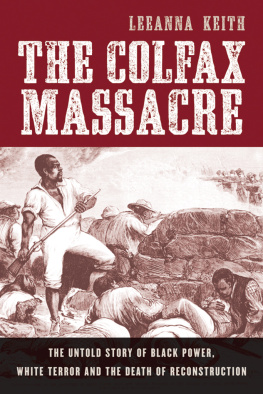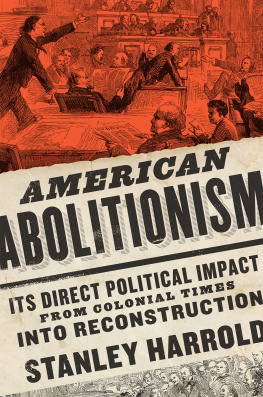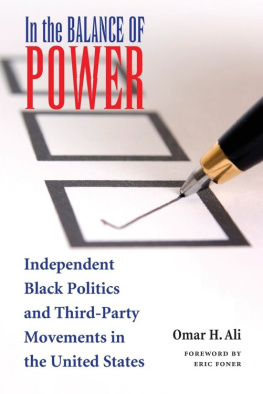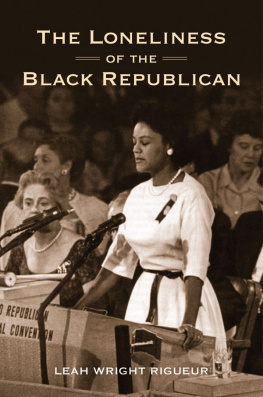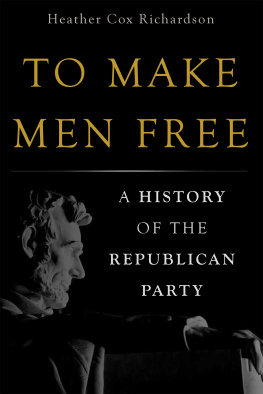The author and publisher have provided this e-book to you for your personal use only. You may not make this e-book publicly available in any way. Copyright infringement is against the law. If you believe the copy of this e-book you are reading infringes on the authors copyright, please notify the publisher at: us.macmillanusa.com/piracy.
The Republican Party was born in a blast that destroyed what historians came to call the second political party system in 1854. Its most ardent faction, the Radical Republicans, helped to destroy slavery and used the conflagration of the Civil War to initiate a revolution in race relations. The first era of Republican supremacy in government, from 1861 to the mid-1870s, produced an ashy aftertaste that has lingered in the politics of the U.S. South for more than 150 years. The daring of the Radicals became notorious, reviled by the now defunct White Supremacy Democrats (18541964) and never celebrated by what came to call itself the Grand Old Party.
When it was grand, the Republican movement asked the most important questions and demanded the most extreme sacrifices of its partisans. Beginning as a tiny minority, antislavery Republicans came to command the creative destruction and Reconstruction of the most politically and economically powerful interest group in American history. Its coalition brought together men and women, whites and blacks, poets, philosophers, captains of industry, and humanitarians of many political stripes. The Radical Republicans dominated their party and transformed the nature of government to achieve their goals.
Radical Republicans of the Civil War era subscribed to a comprehensive conspiracy theory about the plotting of proslavery activists to control government and extend the practice of slavery into Free States and beyond the borders of the United States. They had excellent evidence in support of their claims. More important, they made note of the blueprint of the Slave Power Conspiracy as a model for their own hostile takeover of government.
They dominated the Republican Party, constantly conspiring against coalition partners such as more moderate Republicans, and they thrived as wily conventioneers and parliamentarians. Radicals talked toughfor states rights, for the local nullification of proslavery federal laws, and in favor of the dissolution of the union. They stockpiled armaments, carried weapons on their persons, and used their bodies as weapons. They reveled in war talk, and their militant actions helped to drive the country toward the most destructive war in its history.
The Radicals were culture warriors, committed to a nearly mystical vision of representative government based on free labor. Prizing equal opportunity and expansion, they championed government spending for education and transportation infrastructure, and they celebrated the self-made men and women in their ranks, such as Abraham Lincoln and Frederick Douglass. These Republicans appealed to populism without demonizing capital, being mostly disunited on economic policy questions such as tariffs versus free trade. Most shared the mainstream Republicans respect for property rights, and even partisans of humble origins expected to grow rich amid general prosperity. Wealthy industrialists figured prominently among the Radicals, putting their personal means at the service of armed colonization, slave rescues, and the militant John Brown conspiracy. In wartime they would contribute their organizational expertise, machinery, and capital to both Union victory and racial uplift, demonstrating by wars end that their theory about the superiority of free labor had been true.
Radical Republicans aimed to restore what partisans considered the true history of the American Revolution, including the subverted antislavery intentions of the founding generation. An antislavery interpretation of the Declaration of Independence and the Constitution animated the work of party lawyers and their followers. Historical treatises appeared as landmarks of the Radical ascendancy: Salmon Chases 1842 legal brief on behalf of the slave Matilda, Charles Sumners 1845 speech The True Grandeur of Nations, and the Cooper Union address delivered by Abraham Lincoln early in 1860. Their authors would make America great by restoring the originally intended course of slavery toward its ultimate extinction.
Lawyers such as Lincoln, Sumner, Chase, William Seward, and Thaddeus Stevens led the party in an era of open conflict between state courts and federal law enforcement. Republican-affiliated judges employed writs of habeas corpus to secure the persons and derail the prosecution of detained antislavery activists in an increasing number of cases arising from fugitive slave renditions. Legal aid societies operated formally and informally to assist accused fugitives and those who risked their lives and liberty in antirendition activities. Proslavery pronouncements in the federal courtsparticularly the notorious outcome of Dred Scott v. Sandford (1857)inspired conspiracy theories and official proclamations of noncompliance with Supreme Court rulings by state legislatures. During the Civil War, the Lincoln administration packed the federal courts with Radical judges and agitated to establish operating federal judicial districts in occupied territories. Afterward, Radicals in the Ulysses S. Grant administration fielded an army of race-conscious U.S. attorneys in the newly established Department of Justice.
Radical Republicanism was also a religious and philosophical movement that arose from the evangelical and intellectual boom of the antebellum era. Participants were overwhelmingly Protestant or members of the Unitarian Universalist church. Advocacy for the enslaved stimulated a variety of Christian impulses, as churches and ministers became centers of political and humanitarian agency. Gripped by the plight of fugitives and the violent expansion of slavery to new territories, the Transcendentalist American philosophers Ralph Waldo Emerson and Henry David Thoreau reflected on and reinforced the political work of Radicals. The incredible emotional and physical costs of the Civil War brought existential anguish into the everyday in a way that deeply reinforced religious and philosophical beliefs. Awe, horror, leaps of faith, and religious ecstasy inspired the physical and policy acts of Radical Republicans as well as their interior lives.
Though men predominated and maintained exclusive rights to hold office, women found greater opportunity for participation during the Radical ascendancy than in any previous political moment. The most radical of Republican Radicals were woman suffrage activists of both sexes, while even more mainstream participants supported limited voting rights for women in local elections and in frontier territories. Women speakers and political organizers enjoyed the respect of many men in the Republican Party.
The Civil War Radicals were more racially inclusive than their twenty-first-century counterparts. Even in its earliest months, the Republican Party made room for black men in the movement, seeking their support in Northern states that offered full or qualified voting rights to black men. The early Republican Lewis Hayden in Massachusetts gained a patronage post in the state legislature controlled by Republicans in the 1850s, while John Mercer Langston was the first to hold an elected office, in Oberlin, Ohio. Radicals active in national politics made repeated overtures to Frederick Douglass, who would not commit to the party until 1863 but who later became a Republican for life. The war years introduced a host of active black Republicans into public service in the army, Freedmens Bureau, and missionary agencies, including many who gained election to local and national offices during Reconstruction. Although it did not last, a short-lived program of federal voter registration and election monitoring extended the franchise to the black masses, North and South, producing black-majority districts, black candidates, and responsive white officials in the 1870s.


